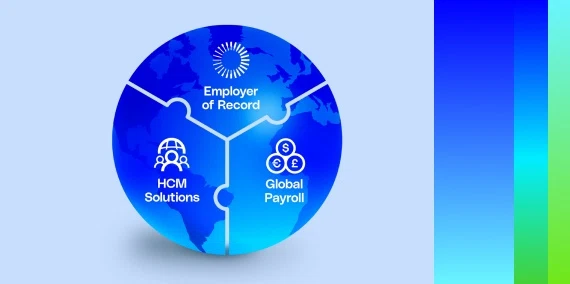Behind every hire is a human being. That’s why every step of the employee lifecycle should be as seamless as possible. A strong talent management process helps an organization minimize employee turnover, boost performance, and keep employees happy.
With a comprehensive Employer of Record (EOR) solution, companies can streamline hiring, onboarding, and even payroll. Let’s explore how to build an effective talent management strategy today — so you can unlock global growth tomorrow.
What is talent management?
Talent management, also known as human capital management, is how employers recruit, build, and retain a productive, engaged workforce. Strategic talent management can help improve overall business performance, strengthen company culture, and ensure a business remains competitive.
Talent management usually includes recruitment, onboarding, engagement, performance, training and development, and other parts of the employee lifecycle. According to McKinsey, organizations that prioritize talent management consistently outperform competitors. By putting talent first, companies can gain a competitive advantage and improve organizational performance.
Talent management vs. talent acquisition: What’s the difference?
Talent acquisition is a part of the talent management framework. Both talent acquisition and talent management are essential to the health of any organization, yet they are not the same. Talent acquisition focuses on bringing in the right talent to the company.
Talent management, on the other hand, helps ensure employees thrive within the organization and contribute to the company’s overall growth. While talent acquisition aligns with the immediate needs of the business, talent management influences the long-term strategic planning of the organization.
What is an effective talent management strategy?
Talent management covers workforce planning, attracting, selecting, developing, retaining, and transitioning talent. What does talent management include? A strong strategy involves a range of employer responsibilities:
- Planning ahead. Determine the necessary human capital, key roles, and employee development plans for a strong business strategy.
- Attracting top talent. Connect with potential job candidates through recruitment campaigns, job posts, and referrals. You can also leverage premium recruiting tools within G-P Meridian Prime™ to find top global talent. Search the best talent pools, anywhere in the world, to find the perfect fit for the role based on your unique needs, including industry and occupation.
- Selecting the right team. High performing employees are up to eight times more productive. Find the best applicants by assessing relevant skills. Behavioral interviews and skill assessments can be highly effective when hiring for more technical roles.
- Developing a comprehensive onboarding and offboarding process. Once an employee is hired, an effective onboarding process is key to improving employee retention and employee performance. Give your team a seamless experience with best-in-class human capital management (HCM) solutions that enable swift and compliant hiring and onboarding in 180+ countries.
- Retaining high-performing employees. Hiring new talent is more expensive than retaining existing talent. According to new benchmarking data from the Society for Human Resource Management (SHRM), the average cost per hire in the United States was USD 4,700. Companies should create career growth and development opportunities, build competitive total compensation packages, and offer increased flexibility to ensure talent retention.
- Transitioning teams. Ensure a smooth onboarding and offboarding experience for your teams. G-P’s Global Growth Platform™ helps handle offboarding with sensitivity, care, and in compliance with local labor laws.
Attracting and retaining talent involves careful management of every step of the employee lifecycle. From recruiting to employee development, HR professionals can improve retention with an effective talent management strategy in place.
What are the six principles of effective global talent management?
Experts from the MIT Sloan Management Review outlined six key principles that make up an effective global talent management strategy. This collaborative research study was built to examine the specific steps global companies can take to help recruit, develop, and deploy the right talent.

Six Principles of Effective Talent Management |
| Alignment with strategy |
| Internal consistency |
| Cultural embeddedness |
| Management involvement |
| Balance of global and local needs |
| Employee branding through differentiation |

These six principles of talent management still hold true in today’s global environment:
- Alignment with strategy. Given your company’s business objectives, what kind of talent do you need? Strategic flexibility is essential for organizations to adapt to evolving business goals.
- Internal consistency. Consistency is key to a strong talent management system. After all, implementing practices in silos may be counterproductive. Internal consistency refers to the way a company’s talent management practices work together. For example, quarterly performance reviews must be conducted across the entire organization in order to successfully address skills gaps.
- Cultural embeddedness. The most successful companies go out of their way to integrate brand core values and principles into every step of the talent management process. From recruitment to succession planning, culture is at the core of a positive employee experience.
- Management involvement. Broad ownership of the talent management process can help successfully drive recruitment, succession planning, and other key business goals. Make sure team leads play a key role in talent recruitment and are directly involved in training and development initiatives.
- Balance of global and local needs. Talent management across multiple countries, cultures, and industries isn’t easy. Research shows that companies should work on responding to local demands while building a coherent global HR strategy and management approach. With a reliable Employer of Record (EOR) solution in place, you can expand and manage teams easily across 180+ countries in full compliance with local laws, without having to set up new entities.
- Employee branding through differentiation. What is your unique selling point for recruiting top talent? Marketing is key to attracting skilled talent.
Be sure to differentiate yourself from competitors in order to attract professionals that align with your core values. Clearly outline the necessary skills for the role and highlight how upskilling aligns with your overall business strategy.
Why is global talent management important?
By planning ahead, leaders can help organizations attract a wider pool of applicants with unique skills, experiences, and perspectives.
One of the biggest challenges global companies face is building — and maintaining — a strong talent pipeline. Talent management can help businesses to:
- Promote succession planning. Identify necessary roles and source top talent with strong skills to fill them.
- Simplify onboarding. With a reliable Employer of Record (EOR) in place, you can bring new hires onto your team starting in just minutes.
- Foster strong employee engagement. Talent management helps allow high-performing employees to collaborate and remain engaged. Research shows that if an organization has an engaged workforce, they are more productive and loyal.
- Streamline benefits. Considered a part of total compensation, competitive benefits are key to attracting and retaining talent. According to G-Ps 2023 Global Growth Report, 49% of employees believe global companies provide access to better pay and benefits. A reliable talent management strategy includes statutory and in-kind benefits.
- Save money. The cost of hiring a new employee can range from 50% to 200% of an employee’s annual salary. For example, the cost of employee turnover can fall anywhere between USD 660,000 and USD 2.6 million per year if your organization employs 100 people with a salary of USD 50,000 per year.
Talent management strategies can reduce turnover by improving the employee experience and reduce one of your company’s biggest expenses: hiring new talent.
Build and manage global teams with G-P.
In today’s evolving business landscape, one thing is clear: Talent management is more important now than ever. But navigating global payroll, ensuring compliance with local employment standards, and managing global teams can be daunting. That’s where G-P comes in.
We help companies build and manage global teams anywhere in the world — without setting up new entities — while maintaining compliance every step of the way. Advanced tools like our Talent Supply Dashboard allow you to customize your acquisition strategy and find your ideal candidates in seconds, putting a world of talent at your fingertips.
As businesses everywhere seek opportunities beyond borders and boundaries, partner with G-P today to unlock global growth.










